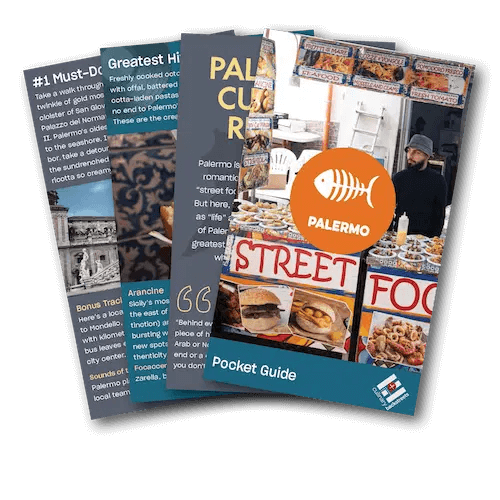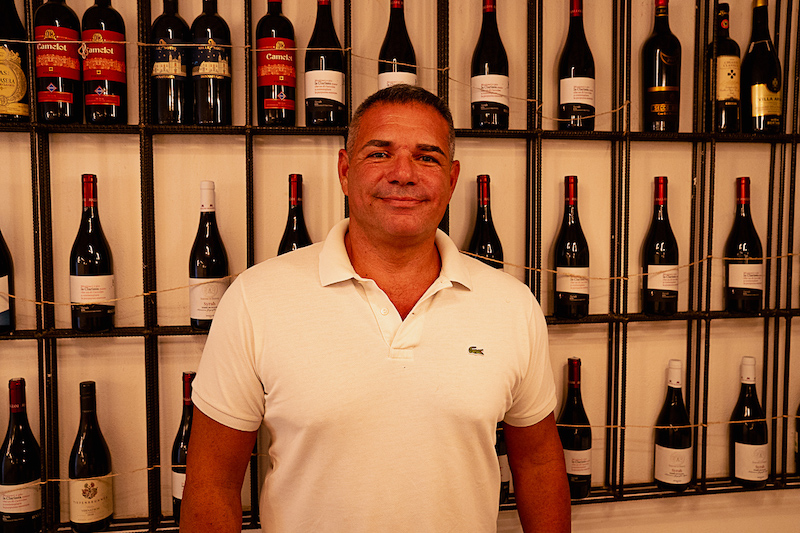We can't find the internet
Attempting to reconnect
Something went wrong!
Hang in there while we get back on track
Palermo
Palermo's culinary record
Sicily has a millennial history that has integrated many different cultures, and Palermo’s culinary scene is the highest expression of this. Here, each dish is not only a simple assemblage of different ingredients, but a living story that wants to be told and savored. Traditional Sicilian cuisine was born from the food of the poor, made from the scraps that the nobles threw away. From this, necessity has been made a virtue; from poverty, the richness of gastronomic creativity has blossomed. This can still be seen today, in the home-style cooking of the old downtown eateries, the sizzling grills of the city’s street food, the sugary assortment of Sicilian pastries.
Get the Full Story →
Get Your Free Palermo Pocket Guide
Introducing our pocket-sized Palermo guide — perfect for your next culinary adventure. Yours free when you sign up for our newsletter.
Get Your Free Palermo Pocket Guide
Introducing our pocket-sized Palermo guide — perfect for your next culinary adventure. Yours free when you sign up for our newsletter.
Visual Dispatches from the Frontlines of Local Eating
Palermo Videos
Your Questions, Answered
Palermo’s vaccination rate is at about 70%. Masks are no longer required, and no specific mandates are in place. As of June 1, 2022, the Green Pass or other equivalent certification is no longer required for entry/return to Italy from abroad.
In Palermo, restaurants are one of the best attractions. From the historic center to the suburbs, all restaurants compete with each other in terms of food quality and deliciousness. While the list is long, right now we love Buatta for typical Sicilian cuisine and Osteria Mercede for the best seafood.
Palermo is the capital of Sicily, the largest island in the Mediterranean, separated from the Italian peninsula by the Strait of Messina. On the northwest of the island, its wide gulf faces the Tyrrhenian Sea. It is Sicily’s most-populated city, with around one million people. The name Palermo comes from Greek and means “all port.” This port city has had a host of different conquerors who have contributed to its many-layered heritage overtime – making Palermo a rich cultural capital in a country already steeped in history.
Direct flights between the United States and Palermo Airport (PMO) are infrequent. Usually, a stopover at major Italian airports such as Rome Fiumicino or Milan Malpensa – or main European airports – is required before connecting to Palermo. It may be possible to find direct flights from JFK to Palermo.
Three-quarters of Palermo is surrounded by mountains, and its gulf opens to the Tyrrhenian Sea. You can enjoy a beautiful seaside promenade within walking distance of the historic center. The nearest beach is about 15 minutes from the city: Mondello, one of the most famous in Sicily, with kilometers of fine white sand. The beach can be reached by car, cab or bus (No. 806) that leaves the center every half hour.
Palermo is relatively cheap compared to many major cities worldwide, especially in Europe or the US. You can have an Italian breakfast for one person from 3 to 5 euros (cappuccino and pastry). Restaurants can be cheap or expensive according to the area but, usually, it is possible to buy a main course meal for 15-20 euros (drink and service included). Street food is very cheap at the market and it is possible to buy a traditional bite for just 2 euros. The average price for a coffee is 1-1.50, and a draft beer is about 4 euros.
Although it is the capital of Sicily, Palermo is relatively small compared to other Italian cities such as Rome and Milan. The city center remains the best place to stay in Palermo while on vacation. From the old town to the more bourgeois districts, there are excellent hotels and B&Bs from which you can walk to all the main sites. We most recommend the area around the Politeama Theater and Massimo Theater.
The best time to discover Palermo is spring and fall because of the mild temperatures, even if it is possible to visit Palermo year-round. Some places will be closed in January and February as it is considered low season, but the main monuments are always open to the public.
Compared to other cities, Palermo is very safe. The Palermitani are friendly and welcoming people. Violent crime in the city is rare, but petty crimes such as pickpocketing can be a nuisance in the market areas. People walk around late at night just as they do during the day, though it’s better to avoid isolated streets or alleys.
The climate in Palermo is Mediterranean, with very mild winters and warm, sunny summers. The Sirocco, a wind from Africa, is capable of raising the temperature by several degrees, sometimes pushing the thermometer past 65 F in winter and 100 F in summer.
There is no need for Americans to obtain a visa to enter Italy for trips of less than three months.
Palermo is soaked in history, art, architecture, culture and good food. The attractions are many, and can please people of all ages, starting fro the UNESCO monuments of the Arab-Norman Itinerary. A stroll in the old town will be unforgettable. Take in the exquisite marble statues of the Fountain of Shame and walk along the seafront at the Cala, the former harbor of Palermo, sipping your Sicilian wine for an aperitivo and admiring the view of Mount Pellegrino, one of the most iconic places in Palermo. Adventurous ones can get lost in the narrow alleys surrounding the historic markets of Palermo, which are for sure not to be missed.
Palermo is world famous for street food. Everywhere on the streets and in the markets you can buy arancine or panelle and crocché, spending no more than 2 euros. There is no shortage of beautiful restaurants where you can discover other traditional dishes that make Palermo’s cuisine unique. Whether in the more traditional family-run restaurants, to the more-chic restaurants with a sea view, it will be possible to enjoy an eggplant Caponata or a pasta dish with sardines. Not to be forgotten are the cannolo or cassata, which will add an addictively sweet touch to your holidays.
Sicilians love children, and Palermo is a diverting city with much to do and eat for children of any age. The city’s cobblestone streets and crowds can make walking with a stroller difficult, but there are many parks and gardens, as well as children’s activities in the city’s major museums.


































